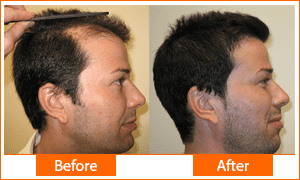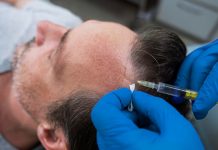Receding hairlines are believed to be triggered by androgenetic alopecia, a hair loss type referred to as male pattern baldness. Androgenetic alopecia is generally a progressive pattern of hair loss that affects 78% of males. Usually, thinning or hair loss begins at the temples and continually pushes back the hairline. The outcomes are normally a widow’s peak or a horseshoe appearance. In other males, the hair loss will partly affect the hairline, but will definitely create a bald spot in the crown region. Unlike men, women also suffer from androgenetic alopecia, although the form is known as female pattern baldness.
In women, hair loss occurs in a completely diffuse manner and may choose to cause a bald spot just in the front region. In addition, one will experience thinning all over the scalp, although the extent differs from one patient to another.
The Actual Cause of a Receding Hairline
There are various factors that can trigger a receding hairline. Most commonly, there is no observed hair loss, but with time, the rate will only escalate regardless of the treatments utilized.
Genetics
In some individuals, a receding hairline is perpetually triggered by genes in case androgenetic alopecia runs in the family. In that case, the genetic predisposition is an obvious determinant. Normally, patients with a genetic predisposition will begin experiencing hair loss as early as 15 years. This also means that your hair follicles are more susceptible to the DHT hormone (Dihydrotestosterone).
Age
Baldness was actually believed to be an adult thing much as the tables turned around. Males above the age of 55 are more likely to develop a receding hairline than younger adults. However, some males may not lose their hair until the age of 70, therefore it differs from one patient to another.
Environmental & Personal factors
These include stress, hormonal changes, dirt accumulation, poor styling methods and others. Traction alopecia is commonly the type of hair loss triggered by tight hairstyles.
Note:
Losing at least 50 – 100 hair strands a day is considered normal, but hair experts stress that a persistent fall of 100 in a day may indeed trigger hair loss. Instances of combing and styling on a regular basis are indeed hair loss triggers in some patients.
Possible Medications for a Receding Hairline.
There are quite a variety of treatments and a combination of them can surprisingly correct your hairline without surgical intervention. These include;
-
Minoxidil
This medication is approved by FDA and commonly used by women, although men can as well utilize it. It is associated with minor side effects, but it is definitely effective in restoring your hairline as well as your natural hair. This medication is usually applied to the affected region twice a day, but for better results, one ought to see a dermatologist.
-
Finasteride
It is a medication commonly used to treat hair loss in males. Its remarkable power in reducing the action of the 5α-reductase enzyme is completely reliable. On the other hand, the drug is associated with a number of side effects that include headaches, dizziness, abnormal ejaculation, and swelling of the hands and feet. Finasteride isn’t recommended for women.
-
Scalp Micropigmentation
This is a stylish hair loss solution where your scalp is injected with a pigment to create a natural appearance of a buzz cut. It is suitable for all males and the last resort in case all other hair restoration techniques fail.
-
Therapies
These are non-surgical hairline restoration procedures performed within a hair transplant centre or salon. These therapies include Platelet Rich Plasma (PRP), Stem Cell Therapy and Mesotherapy. They are ideal for both males and females.
-
Hair Transplants

Hair transplants are surgical hairline restoration techniques and they include FUE (Follicular Unit Extraction) and FUT (Follicular Unit Transplantation or Strip Method).




